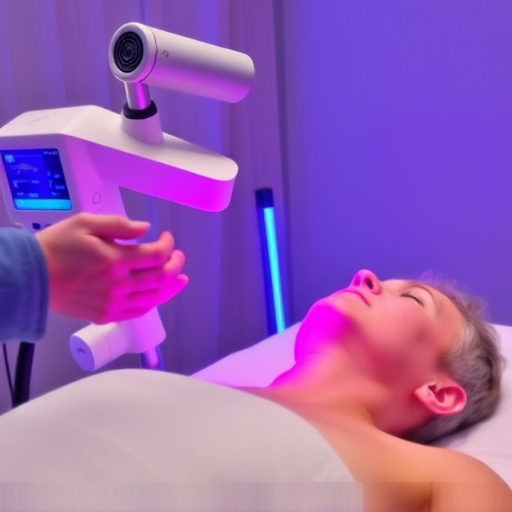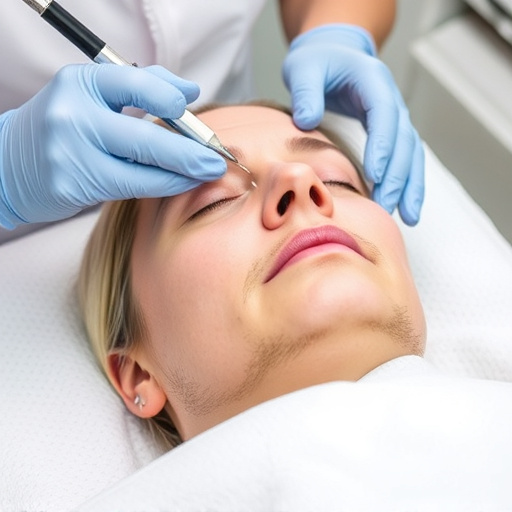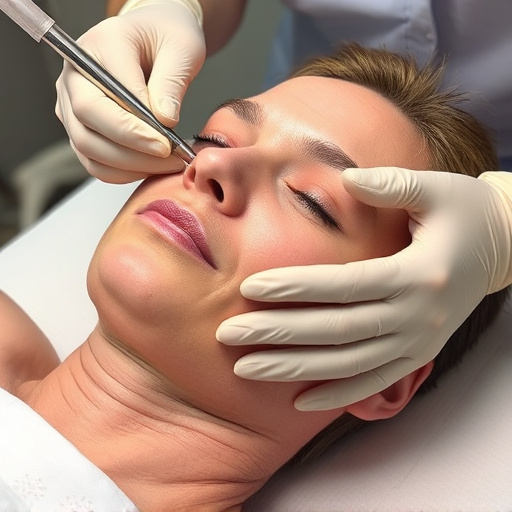Melasma, or the "mask of pregnancy," is a skin condition caused by hormonal fluctuations, sun exposure, and certain products. Management involves specialized skincare routines and treatments like hydroquinone, retinoids, vitamin C, IPL therapy, microdermabrasion, RF treatments, micro-needling, and topical medications. Postpartum, a range of options become available for long-term management. Essential post-pregnancy skincare includes gentle cleaning, hydrating toner, moisturizer, SPF protection, and chemical peels or microdermabrasion under dermatological guidance.
Melasma, often referred to as ‘pregnancy mask,’ is a common skin condition characterized by dark patches on the face. This article guides you through managing melasma during and after pregnancy. We’ll explore the causes and triggers, from hormonal changes to sun exposure, offering effective treatment options ranging from topical creams to lifestyle adjustments. Additionally, we provide a post-pregnancy skincare routine to help fade melasma for long-lasting clear and radiant skin. Discover expert tips on achieving a melasma treatment that works for you.
- Understanding Melasma: Causes and Common Triggers
- Effective Melasma Treatment Options During and After Pregnancy
- Post-Pregnancy Skincare Routine for Managing Melasma Long-Term
Understanding Melasma: Causes and Common Triggers

Melasma, often referred to as the “mask of pregnancy,” is a common skin condition characterized by dark patches on the face, typically appearing on the cheeks, forehead, and upper lip. While it primarily affects women during and after pregnancy, it can also occur in men, usually due to hormonal imbalances. Understanding what causes melasma is crucial for effective management.
The primary trigger for melasma is fluctuating hormone levels, especially an increase in estrogen and progesterone. This hormonal shift can stimulate the melanocytes, cells responsible for producing melanin, leading to excessive pigment production. Common triggers include pregnancy, birth control pills or hormonal replacement therapy, sun exposure, and certain skin care products. Maintaining optimal skin health and employing suitable melasma treatment strategies, such as professional skincare routines and anti-aging treatments, can help minimize its appearance and promote a more even complexion.
Effective Melasma Treatment Options During and After Pregnancy

Melasma treatment during and after pregnancy involves a combination of topical and non-invasive procedures. For expectant mothers, it’s crucial to opt for gentle, safe options that won’t harm the baby. Over-the-counter creams containing ingredients like hydroquinone (in recommended concentrations), retinoids, or vitamin C can help lighten dark patches. Chemical peels and laser treatments should be avoided during pregnancy due to potential risks.
Postpartum, a range of melasma treatment options becomes more accessible. Professional skin care experts recommend advanced procedures such as intense pulsed light (IPL) therapy, microdermabrasion, or body contouring techniques like radiofrequency (RF) treatments for targeted skin rejuvenation. Additionally, anti-aging treatments like micro-needling or topical prescription medications can address residual hyperpigmentation, promoting a more even skin tone and a youthful appearance.
Post-Pregnancy Skincare Routine for Managing Melasma Long-Term

Post-pregnancy skincare is an essential aspect of managing melasma long-term. After giving birth, your skin has gone through significant changes and may still be recovering. A gentle yet consistent skincare routine can help to fade existing melasma and prevent future discoloration. Start by cleansing your face twice daily with a mild cleanser suitable for sensitive skin. This removes excess oil, makeup, and environmental impurities without stripping away natural moisture. Follow up with a hydrating toner and a lightweight, non-comedogenic moisturizer. Sun protection is crucial; always apply a broad-spectrum SPF 30 or higher every morning to protect against UV rays that can worsen melasma.
Consider incorporating medical spa services like chemical peels or microdermabrasion into your routine, as these treatments can help exfoliate the skin and improve texture, potentially lightening the appearance of melasma. Skin tightening procedures might also be recommended for some individuals to reduce the visibility of hyperpigmentation. Always consult a dermatologist before trying any new treatments, especially post-pregnancy, to ensure safety and effectiveness tailored to your specific needs.
Melasma, often referred to as ‘the mask of pregnancy,’ can be a challenging skin condition to manage. However, with the right approach, it is possible to effectively treat and minimize its appearance during and after pregnancy. By understanding the causes and triggers, exploring various treatment options, and implementing a dedicated skincare routine, new mothers can take control of their skin’s health. Remember, consistent care and patience are key to achieving a clearer complexion. With dedication, you can navigate this journey and embrace your post-pregnancy skin with confidence, knowing you’ve taken proactive steps towards melasma treatment and long-term management.














